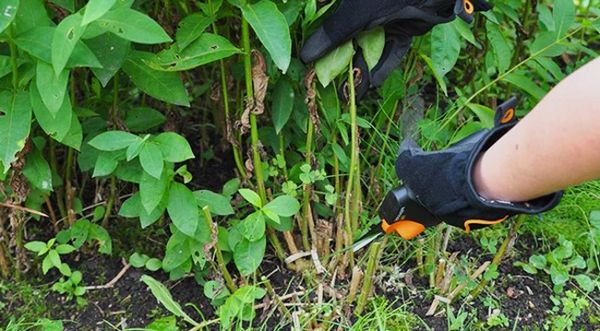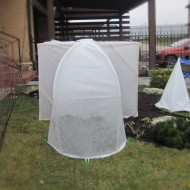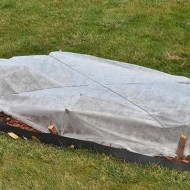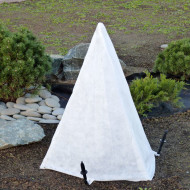Recommendations for preparing phlox for the winter from experienced florists
Content
Pruning work
Autumn care for phlox consists of the usual agrotechnical measures: water-charging irrigation, fungicide treatment, pruning, fertilizing, soil mulching and shelter. Not all gardeners and gardeners believe that phloxes need to be cut in the fall. However, the procedure not only stimulates the growth and development of new shoots in the spring. Sanitary pruning protects against pests and fungal infections, whose spores and larvae can hide in wilted foliage and dead plant parts. Also, cut bushes are easier to handle (spray and mulch).
Timely pruning allows the roots to accumulate the full amount of nutrients necessary for wintering. Nutrition of the root system is the key to a successful wintering of the flower. The pruning time depends on two factors - the type of phlox and the climatic characteristics of the region. The early bushes are pruned at the end of September, the late ones from the middle of October. They start pruning only after the plant has completely bloomed, and nutrients from the green parts begin to flow to the root system. Finish the procedure before the onset of permanent frost.
Phlox are cut in three ways:
- All shoots are cut off, leaving stumps several centimeters high. Almost complete removal of the aerial part reduces the risk of developing fungal diseases to a minimum. Pests accumulated in it are also removed along with the vegetation.
- The aerial part is cut in such a way that stumps of 7–10 cm remain. These stumps become the basis for the development of young spring shoots. However, according to experience, they are weaker and bloom worse than those that grow directly from the roots.
- After pruning, the aerial portion remains more than 10 cm. Most gardeners will prune the plant this way. Although the remaining part is problematic to process, and the risk of pests and fungal spores overwintering in it is quite high. This pruning scheme is good in regions where there is a lot of snow in the winter.
Timing is an important point in the procedure. If you prune phloxes too early, they will sprout new shoots before the cold weather sets in. Late pruning will prevent the root system from accumulating enough nutrients for the dormant period.
Video "Preparing phlox for winter"
In this video, you will learn how to properly prepare phlox for the winter period.
Top dressing after the procedure
After pruning, the flower needs to be watered and processed. It is recommended to burn all trimmed parts away from any cultivated plants. You can destroy fungal spores using fungicide treatment. Before feeding, the near-stem zone must be loosened and watered abundantly. Further, mineral fertilizers are applied under the bush. Usually superphosphate is mixed with ash in small quantities.
Shelter before the onset of cold weather
Preparing a flower for winter does not end with the care measures listed above. Whether it is necessary to cover phloxes for the winter depends on the growing region and crop variety.Depending on the growing area of the phlox, it may need different types of shelter. Subulate phlox, which are usually grown in our country, tolerate mild continental winters well. However, frosts below 15 ° C can kill the plant. The danger for the plant is not only severe frosts, but also long thaws: the flower can have time to start up young shoots, which will be further frostbitten. Also, the scorching rays of the sun can burn the remaining stems. Therefore, it is recommended to cover not only frost-resistant varieties, but also others.
Before sheltering, phloxes must be prepared: mulch with peat, compost or humus. To insulate the plant, you need a layer of about 10 cm. Then the bush can be covered with spruce branches, which retains snow, but lets air through. It is impossible to cover phloxes with special airtight materials (film, linoleum) - the lack of ventilation and a lack of moisture contribute to the development of the decay process. The shelter is removed immediately after the end of the period of frost and strong night frosts.
The nuances of the procedure in different areas
The method of sheltering phlox for the winter and its need directly depends on the place where the flower is grown. Winter in the middle lane, in particular in the Moscow region, is not too harsh. Therefore, rotted manure is used as insulation for the bush. In the regions of the Volga region, hemp is not cut at the very root, but left about 8 cm, mulched and covered with branches or tops. The same shelter scheme is also suitable for the Urals; a layer of snow is laid on top of such a shelter. Siberia, with its harsh winters and bitter frosts, will need a better shelter. The plant is not cut off or left about 20 cm, completely covered with mulch and covered with spruce branches or corn (or sunflower) tops. It is also practiced to dig up a flower and place it in a container, which is transferred to a cool room.
Fatal mistakes of inexperienced florists
Simple summer residents and novice florists can make a number of typical mistakes in caring for phlox:
- application of nitrogen-containing fertilizers before wintering: such feeding stimulates the growth of new shoots, as a result of the growth of which the root system does not receive the necessary nutrients;
- too hasty warming of the plant: do not cover the flower before the onset of regular frosts;
- the use of materials for shelter that do not allow air and moisture to pass through;
- incorrect cropping.
First aid for freezing
If the bush is slightly frozen, then you should not despair right away. You can try to revive it. It is necessary to cut out the middle of the bush with a sharp sterile knife, leaving only the edges by 3-4 cm. Then the resulting void is covered with nutritious soil and treated with a growth stimulator.
After treatment, the growth of dormant buds is stimulated, which will release new shoots.
It is not difficult to take care of phlox, the main thing is to do everything in a timely manner, using simple tips.





